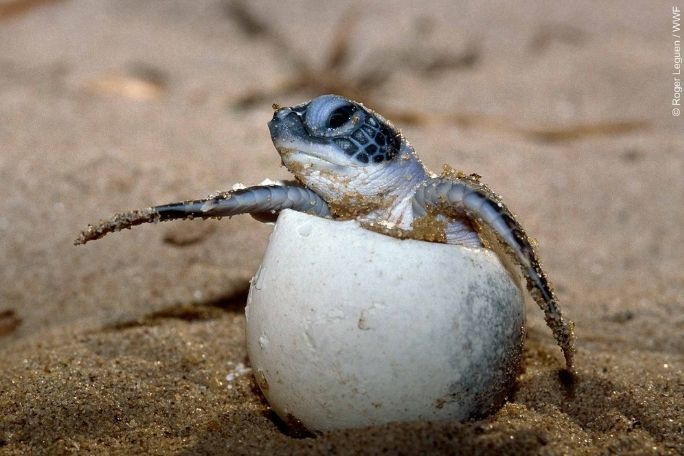Lesson summary
In this lesson students will explore a range of marine turtle nest protectors and evaluate the threats they provide protection against. Students will then design and construct their own nest protectors in order to help conserve marine turtles. Using design thinking, students work collaboratively to brainstorm, develop, design and construct a turtle nest protector. They will pitch their ideas to the class or an audience of experts. Finally, students are asked to reflect upon the success of their project and their role in creating and executing the project. This lesson can be used to follow Threats to Marine Turtles – Year 4, 5 & 6 – Lesson 1.
Essential questions:
- How can turtle nest protectors help marine turtles?
- What could a nest protector look like? What materials could it be made of and how would it work?
- What actions can we take in our school or community to help protect marine turtles?
- What processes and steps are required for planning and executing a social action project?
Learning intentions
Students will...
- understand that turtle nest protectors are a practical way of protecting incubating turtle eggs from a range of threats.
Success criteria:
Students can...
- plan and design a project
- work collaboratively from the start of the project to its completion
- critically reflect on their own contributions to the success of a project
- know that turtle nest protectors come in different shapes and sizes and are made from different materials, depending on local threats.
Lesson guides and printables
Lesson details
Curriculum mapping
Australian Curriculum content descriptions:
Year 4 Science:
- Living things depend on each other and the environment to survive (ACSSU073)
- Science knowledge helps people to understand the effect of their actions (ACSHE062)
Year 5 Science:
- Living things have structural features and adaptations that help them to survive in their environment (ACSSU043)
- Scientific knowledge is used to solve problems and inform personal and community decisions (ACSHE083)
Year 6 Science:
- The growth and survival of living things are affected by physical conditions of their environment (ACSSU094)
- Scientific knowledge is used to solve problems and inform personal and community decisions (ACSHE100)
Year 5 HASS – Geography:
- The environmental and human influences on the location and characteristics of a place and the management of spaces within them (ACHASSK113)
Syllabus outcomes: ST3-10LW, ST3-11LW, GE3-2, GE3-3.
General capabilities: Critical and Creative Thinking.
Cross-curriculum priority: Sustainability OI.2, OI.7, OI.9.
Relevant parts of Year 4 Science achievement standards: Students describe relationships that assist the survival of living things and identify when science is used to understand the effect of their actions.
Relevant parts of Year 5 Science achievement standards: Students analyse how the form of living things enables them to function in their environments. Students discuss how scientific developments have affected people’s lives, help us solve problems and how science knowledge develops from many people’s contributions.
Relevant parts of Year 6 Science achievement standards: Students describe and predict the effect of environmental changes on individual living things. Students explain how scientific knowledge helps us to solve problems and inform decisions and identify historical and cultural contributions.
Relevant parts of Year 5 HASS – Geography achievement standards: Students identify and describe the interconnections between people and the environmental characteristics of places.
Time required: 180+ mins (allow enough time for the construction of the nest protectors)
Level of teacher scaffolding: Medium – oversee lesson and lead students in class discussions and brainstorm session.
Resources required
- Student Worksheet – one copy per student OR computers/tablets to access the online worksheet
- Device capable of presenting a website to the class
- All About Turtles – Factsheet. Turtle Nest Protector Image Sheets
- Group Roles
- Plan the Perfect Pitch Factsheet
- Pitch Assessment Rubric
- Butcher’s paper, A3 paper and pens
- Materials for making posters or signs
- Materials for making nest protectors such as shade cloth, wood planks, rope, hot glue gun, rulers, plastic lattice, scrap metal (non-ferrous) and hammer and nails
- String, masking tape or chalk, A4 paper sign saying AGREE, A4 paper sign saying STRONGLY DISAGREE
Skills
This lesson is designed to build students’ competencies in the following skills:
- Collaboration
- Communication
- Creativity
- Critical thinking
- Community engagement
- Problem solving
Additional info
This lesson has been developed in partnership with WWF-Australia. WWF-Australia has been working to conserve marine turtles and the habitats they live in. Following this lesson plan is an ideal way for your school to celebrate World Turtle Day on the 23rd of May. Join with other amazing teachers and students around Australia who are taking action to conserve marine turtles.


Welcome back!
Don't have an account yet?
Log in with:
By signing up to Cool.org you consent and agree to Cool's privacy policy to
store, manage and process your personal information. To read more, please see
our privacy policy here(Opens in new tab).
Create your free Cool.org account.
Many of our resources are free, with an option to upgrade to Cool+ for premium content.
Already have an account?
Sign up with:
By signing up to Cool.org you consent and agree to Cool's privacy policy to
store, manage and process your personal information. To read more, please see
our privacy policy here(Opens in new tab).